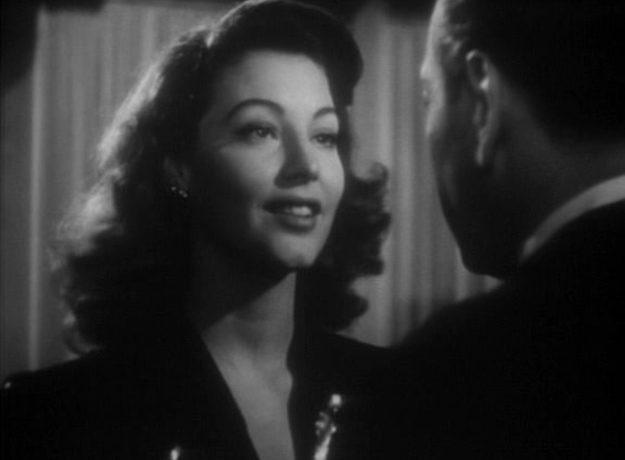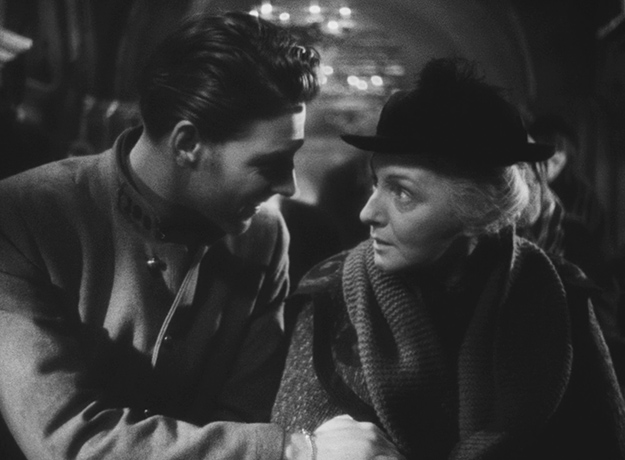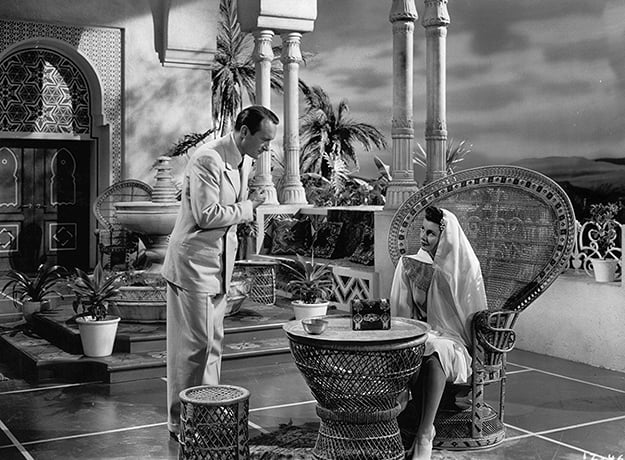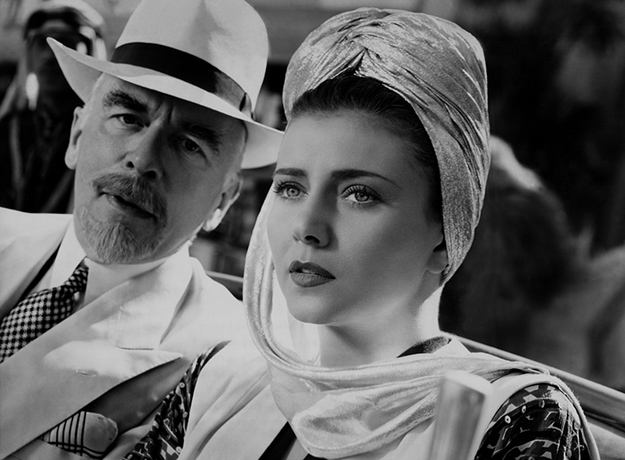TCM Diary: Léonide Moguy

Whistle Stop
For some of the best years of his working life, Léonide Moguy operated without a permanent fixed address. This was a condition forced on many European filmmakers by the circumstances of World War II, a global conflagration that would influence Moguy’s later humanitarian efforts and find its way into his handful of American films. While Moguy worked more extensively in France and Italy before and after the war, the output from his brief Hollywood stopover is limited to three features: Paris After Dark (1943), Action in Arabia (1944), and Whistle Stop (1946). Both Paris After Dark and Action in Arabia were wartime adventure films, Moguy’s soundstage contributions to the conflict overseas.
A puff piece on Moguy in the New York Herald Tribune of February 13, 1944, rather transparently meant to gin up interest in the director’s forthcoming Action in Arabia, made a point of establishing its subject as someone with an intimate knowledge of cloak-and-dagger skullduggery. His previous Hollywood production, Paris After Dark, had been set in the world of the French Resistance, and so Moguy was identified as “a man who lived in France’s hours of agony when town and country were honeycombed with provocateurs, saboteurs and spies plain and fancy.” Moreover, the article continues, Moguy and his Action in Arabia screenwriter Herbert J. Biberman were planning a project on a Mata Hari-esque actress whom Moguy had encountered while working in the French film industry, now in the good graces of the German occupational command. “Her life won’t be worth much after the war,” Moguy is quoted as saying. “I met her in Paris when I was directing a picture with her before the war—a picture which had to be killed in the middle of production on orders from a high government official . . . It would make a great picture, that woman’s career . . . But first we must wait for the war to end and see how the last chapter of her life turns out.”
Beyond the ballyhoo, there is some real reflection here of what was going on in the strife-wracked Europe that Moguy had so recently escaped. Given Moguy’s reference to a “killed” production we must assume that the movie in question is his 1940 L’empreinte du Dieu, whose shoot was interrupted by the declaration of war between France and Germany, during which time one of the original stars, Dita Parlo, born a Kornstädt in Pomerania, was blacklisted under suspicion as an enemy alien from the French industry, to which her most famous contribution had been her role in Jean Renoir’s La Grande Illusion (1937), in which she plays the war widow who washes the wounded foot of the Jewish Marcel Dalio. Parlo’s previous pursuit of an American career synchs with Moguy’s comments about his Mata Hari’s presence in New York and Los Angeles, seeming to confirm that she was indeed the double agent that he had in mind, though after the war, despite great scrutiny of Parlo, no solid evidence was ever produced to convict her as a Nazi sympathizer.

Je t’attendrai
Showfolk in Europe, like most everybody else on the continent, were caught up in shifting allegiances, contingency plans, and flesh-and-blood commitments—like that of Jean-Pierre Aumont, Luchaire’s Jewish co-star in Je t’attendrai, who served with distinguishing valor in De Gaulle’s Free French Forces. For those who’d fled to Hollywood, however, wartime was mostly a matter of improvising a career in a strange land. Moguy had every inducement to beat feet out of Europe after the fall of France, for he was Jewish, and named as such in a vile jeremiad condemning the control and corruption of French cinema by Jewish foreigners published by Rebatet in 1941, placing Moguy in the illustrious company of Robert Siodmak, Max Ophüls, and Anatole Litvak, many of whom had fled Vichy already.
Moguy’s war films both star George Sanders, the English actor who, curiously enough, may have shared his director’s hometown, St. Petersburg, Russia—I say “may” because, while there is no doubt that Sanders’s boyhood address was 6 Petrovski Ostrov, various sources list Moguy as either a Petersburger or a native of Odessa, Ukraine. Though Sanders was already carving out a niche as one of Hollywood’s most promising bastards, in the first half of the 1940s he was still best known to audiences as the suave protagonist of two series of B action movies. He had appeared in five films as The Saint, alter-ego of debonair good-bad burglar Simon Templar and the creation of Leslie Charteris, whose quarrels with studio RKO led to their creation of knock-off the Falcon to keep Sanders busy.
In between these expeditions, Sanders was kept busy fighting World War II on celluloid—playing Nazis and collaborationists for Litvak, Fritz Lang, and Jean Renoir in Confessions of a Nazi Spy (1939), Man Hunt (1941), and This Land is Mine (1943), among others, while taking the Allied side in Alfred Hitchcock’s Foreign Correspondent (1940), Appointment in Berlin (1943), and the vigorous Paris After Dark, which has him as an aristocratic Paris surgeon attached to a Nazi munitions plant who moonlights as a Resistance operative. The plot of Paris After Dark hinges on the reconversion of a disillusioned French soldier (the Dutch Philip Dorn) to the anti-fascist cause, and in this it seems to anticipate Michael Curtiz’s Passage to Marseille (1944). The shadow of another Bogart vehicle, Casablanca (1942), hangs over Action in Arabia, which starts with its own scene-setting narration, introducing us to “Damascus, the oldest city in the world—for untold centuries the political center and metropolis of the Arab world. Damascus—under the placid surface of its age-old civilization, a breeding place for espionage and intrigue.”

Action in Arabia
Into the nest of vipers arrives Sanders, playing an American journalist named Michael Gordon. (A side note: posh Brits provided a far better service to American pictures when they made no attempt to disguise their Posh Britness behind strained, accent-stifling gruffness.) The intrigues of the day surround attempts by both Allied and Axis agents to obtain the loyalty of the thus-far neutral Arab states, in this case desert tribesman, with an idea that whoever does so will ultimately have control of the Suez Canal, and thus the Mediterranean. Gordon, who seems to stir up controversy wherever he goes, is thrust into the midst of this when a colleague from Philadelphia is discovered in the city souk with a knife thrust in his back. This leaves Gordon to figure out the why and how, and being George Sanders, he keeps up a brave front of limpid perturbation as he does so.
Very quickly the movie brings in a long lineup of characters and suspects. There is Yvonne (Virginia Bruce), a glamour girl who Gordon meets in the gaming room of the swank Hotel International, where he’s staying; the hotel’s owner, Eric Latimer (Alan Napier), a known Nazi sympathizer; and Josef Danesco (Gene Lockhart), a wheedling little character who hangs around the lobby offering the sale of information. There is also a French diplomat (André Charlot) who seems to be the harbinger of a fall to fascism wherever he goes; a sly, skulking henchman with uncertain loyalties (Dalio himself, also in Paris After Dark); an initially dubious agent of the American Consulate, Matthew Reed (Robert Armstrong), who tries to run meddlesome Gordon out of town; and a bevy of Arab dignitaries including Adbul El Rashid (H.B. Warner), his Western-educated daughter (Lenore Aubert), and an upstart chieftain (Jamiel Hasson) who intends to throw the support of the tribes behind the Axis powers.
This is a lot for any movie to take on, much less a movie with a prohibitive 75-minute length, but Moguy works with invisible economy, keeping his cast in constant circulation as they lead the camera across showoff surveys of large sets including the Hotel International and the souk, designed by RKO stalwarts Albert S. D’Agostino and Al Herman. In a single stroll through the souk which occupies less than five minutes of screen time Sanders exchanges threats and then blows with Dalio, waves unbidden at El Rashid and daughter as they pass in a convertible, extracts an address from Danesco, and pauses briefly to taunt Reed at a melon vendor’s stall before going on his way.

Action in Arabia
Moguy, working here with the redoubtable cutter Robert Swink, was distinguished by his skill as an editor, a talent honed through a long apprenticeship in newsreels and then features which took him from Kiev to Moscow to Paris, and which kept him at work long after the directorial opportunities had dried up. A Variety article from March 1, 1967, reporting on his distilling Soviet director Sergei Bondarchuk’s seven-hour War & Peace into something that could be screened in a single sitting at behest of distributor Jean Mauclair refers to his reputation as “the surgeon of French motion pictures.” This ability not only shows in the crisp pacing of Action in Arabia, but in the film’s integration of stock footage in scenes where Gordon makes off with a small prop plane and goes to investigate goings-on in the desert. Working at RKO, Moguy and Swink had access to aerial footage of Bedouin caravans shot by King Kong filmmakers Ernest B. Schoedsack and Merian C. Cooper for an unrealized Lawrence of Arabia project, and using this they were able to successfully create the impression of a grand tribal council coming together.
Contemporary commentators were not impressed by this note of authenticity in the otherwise backlot-bound film. “There is almost nothing in Action in Arabia which could not have been conceived by any bright young person who never got closer to Damascus than Hoboken” wrote the critic for the New York Herald Tribune upon the movie’s opening at the RKO Palace on Broadway and 47th St., currently hosting the Spongebob Squarepants musical. The very strength of the movie, its fleet-footed pacing, offended Wanda Hale at the Daily News, who diagnoses “too much movement and too little story.” Despite the measured praise of the New York Sun (“juvenile in its mood, brisk in its telling, well enough in its acting, and in its production more lavish than most of its kind”), most notices tended to the dismissive, and Moguy, who in the abovementioned Herald Tribune piece was identified as taking English lessons at Hollywood High School, would find little further use for the language in his filmmaking career. The box-office performance of Action in Arabia was apparently insufficient to draw a contract from RKO, and his last American offering, Whistle Stop, was made under the auspices of Nero Films, the brainchild of another émigré, Seymour “Sy” Nebenzal, who with his father, Heinrich, had operated Berlin’s Nero-Film before the war, responsible for financing canonical works by Lang, G.W. Pabst, and others.
Nebenzal would stick around Hollywood for a while longer, producing Joseph Losey’s 1951 remake of Nero-Film’s most famous property, M, but by 1947 Moguy was back in France, building another fantasia of the Arab world at the Studios de Billancourt for the Danielle Darrieux vehicle Bethsabée. Moguy’s last directorial assignment, Les Hommes veulent vivre, was released in 1961, though he appears to have remained active to the end of his life. A 1973 item in the International Herald Tribune identifies Moguy as having been converted to the “mondialist” global pacifist movement by prestige brand ambassador Albert Einstein, and describes a film called One World or None slated to begin shooting in July, featuring 20 Nobel Prize winners in a film which will record “the scourges that threaten humanity today—the population explosion, ineffectually controlled, which condemns hundreds of millions of children to poverty and starvation; the disparity between technological progress and moral progress; the threat of world war; increasing pollution and the insufficient means of succoring the victims of natural disasters—and to propose solutions for these pressing problems.”
This project was never completed, nor the in-progress “montage pic” Quo Vadis 2000 described in a 1977 obituary which identified Moguy as having been supervising the film activities of the International Red Cross at the end of his life. The dissolution of nation states and peace in our time is a tall order for anyone to chronicle, much less a talented utility man director, and Moguy wasn’t quite able to deliver on it in his lifetime—though with the help of Hollywood and a game George Sanders, he did his part to put the Axis powers on the run.
Action in Arabia airs December 7 on Turner Classic Movies.
Nick Pinkerton is a regular contributor to Film Comment and a member of the New York Film Critics Circle.







